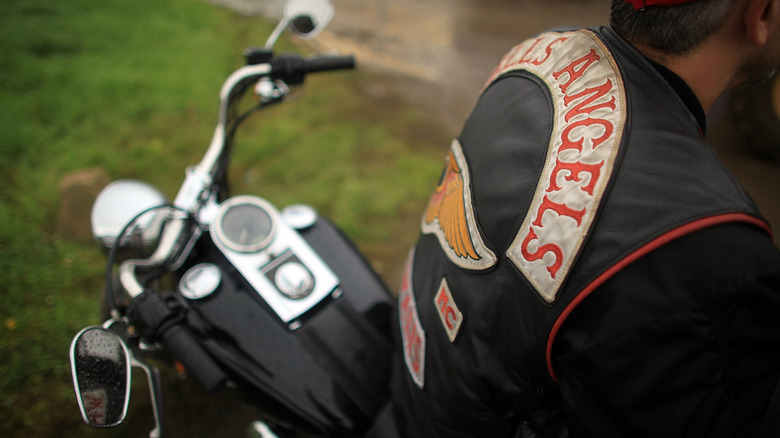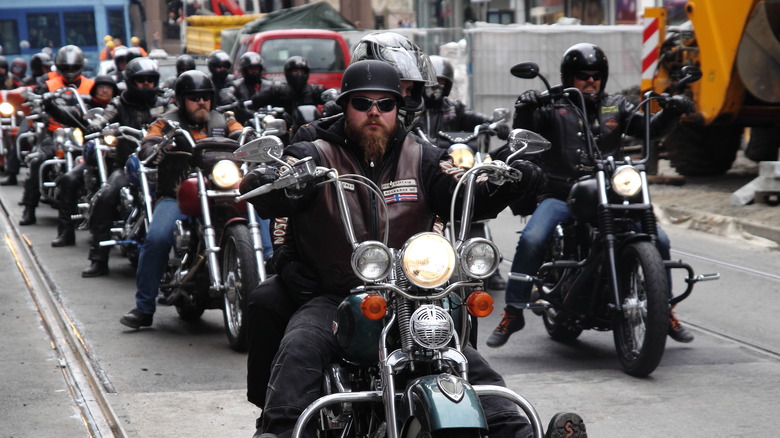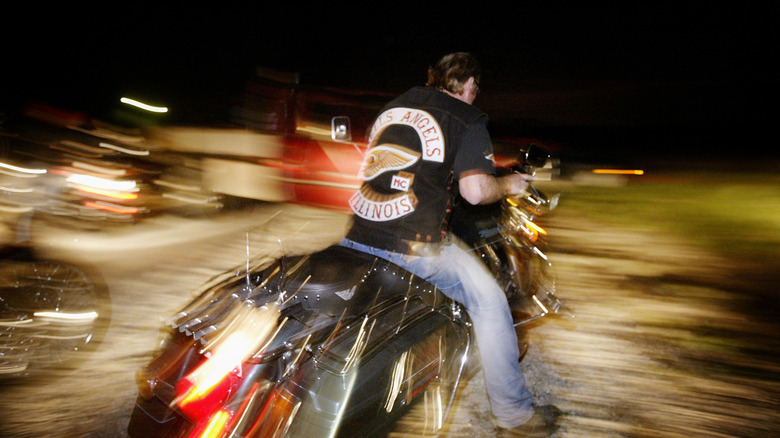Were The Hells Angels Connected To The Waco Shoot-Out?
For a few minutes on Sunday, May 18, 2015, a suburban shopping center in Waco, Texas, was turned into a modern tribute to the city's Wild West past. The Washington Post reports that a biker brawl erupted into an all-out gunfight at a Twin Peaks franchise there just after the clock struck high noon. Members of rival biker gangs used chains, clubs, brass knuckles, knives, pistols, and even AK-47 assault rifles to go at each other's throats until the police were able to get control of the situation, which involved police having to fire their weapons. When the fighting settled, nine bikers were dead and another 20 people were injured. Police arrested 177 people, according to NPR.
Waco Police Sgt. W. Patrick Swanton said of the situation: "In 34 years of law enforcement, this is the worst crime scene, the most violent crime scene I have ever been involved in."
When we hear of a biker brawl, you might be quick to assume that it involved the most notorious leather-bound baddies in our popular imagination, the Hells Angels. However, you'd be accused of unfair stereotyping, because as HotCars points out, violent, drug smuggling bikers can do nice things like donate to food banks and take part in the political process, too. Just because they killed one hippie at a Rolling Stones concert decades ago doesn't mean they're all bad guys. So check your biker prejudice at the door and let's take a look at who really was involved in the 2015 Waco biker shoot-out.
The bikers involved in the Waco shoot-out were 1 percenters
As police were aware before the shoot-out, the rivalry that boiled over into violence in Waco that day involved several different biker gangs allied against each other. The Los Angeles Times reports that the two main rivals that day were called the Cossacks and the Bandidos, but a total of five motorcycle clubs were involved in the parking lot brawl that originated in a bathroom of the restaurant.
The Cossacks and the Banditos both identify "one-percenters," a biker term that stemmed from a statement made after a motorcycle rally went sideways in Hollister California in 1947 and the event turned violent. According to the Western Journal of Emergency Medicine, a member of the American Motorcycle Association said at the time, "Ninety-nine percent of the motorcycling public are law-abiding; there are 1% who are not." These one-percenters consider themselves "the baddest of the bad."
One unidentified Waco law enforcement official said that members of both gangs wear "one percent" patches on their vests to proudly display how they feel united in their lawlessness. This also means that they are considered willing participants in organized criminal activity.
According to the Cossacks' website, their crew lost seven men that day, whom they refer to as the "Waco 7." The Cossacks vow on their site to "NEVER FORGIVE and NEVER FORGET!" As for the Banditos, their memorial page doesn't specify how the 20 fallen brothers pictured died, but their slogan is telling. It says, "We are the people our parents warned us about."
The Hells Angels weren't part of the shoot out in Waco
Though they weren't involved with this particular kerfuffle, the Hells Angels still consider themselves to be one-percenters, and therefore, above the law. According to the U.S. Department of Justice, there are around 300 Outlaw Motorcycle Gangs, or OMGs, operating in the U.S., with the Hells Angels, Bandidos, Mongols, Outlaws, and Sons of Silence having the vastest criminal enterprises that are heavily involved in drug trafficking and smuggling, both domestically and internationally. With so many bad dudes out there dedicated to competing causes who also have no scruples about getting violent, biker gang clashes are bound to happen.
This was by no means Waco's first shoot-out or siege, and Waco Police Sgt. W. Patrick Swanton said biker gang crime and violence is an issue that extends far beyond his jurisdiction. "This is not a Waco problem," Swanton said, "this is a national problem," per the Los Angeles Times.
In the end, in 2019 all of the charges and subsequent 155 grand jury indictments alleging involvement in organized crimes were dropped. No one was ever held accountable for the deaths, injuries, and violence outside of the Twin Peaks that day in May 2015, according to NPR, which reported that it's believed four of those killed were shot by police. Still, none of the violence or killings were perpetrated by one of the most notorious motorcycle gangs in the U.S., The Hells Angels.


